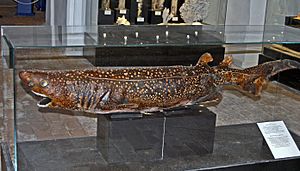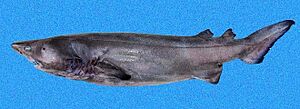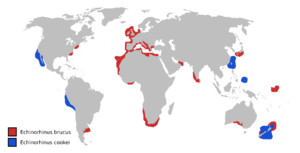Echinorhinus facts for kids
Quick facts for kids Echinorhinus |
|
|---|---|
 |
|
| Bramble shark, Echinorhinus brucus; mounted specimen, Natural History Museum of the University of Pisa | |
 |
|
| Prickly shark, Echinorhinus cookei | |
| Scientific classification |
|
| Kingdom: | Animalia |
| Phylum: | Chordata |
| Class: | Chondrichthyes |
| Infraclass: | Euselachii |
| Superorder: | Selachimorpha |
| Order: | Squaliformes de Buen, 1926 |
| Family: | Echinorhinidae T. N. Gill, 1862 |
| Genus: | Echinorhinus Blainville, 1816 |
 |
|
| The distribution of the two Echinorhinus species | |
The Echinorhinus is a fascinating group of sharks. It is the only living group in the family Echinorhinidae. These sharks are sometimes placed in a larger group called Squaliformes, or they might even have their very own special group, the Echinorhiniformes. What makes them truly stand out are the large, thorn-like spines covering their skin.
Contents
Discovering Bramble and Prickly Sharks
These unique sharks are not seen very often. Scientists are still learning a lot about them. They are known for their rough skin and mysterious ways of life in the deep ocean.
What Makes These Sharks Special?
Scientists like to organize living things into groups to understand how they are related. This is called taxonomy. The Echinorhinidae family, which includes the Echinorhinus sharks, has been a bit tricky to classify.
Originally, these sharks were often grouped with other sharks like dogfish and gulper sharks in the Squaliformes order. However, new studies looking at their DNA suggest they might be different. Some scientists now think they could be more closely related to angel sharks or sawsharks. Because of these differences, some experts believe these sharks should have their own special group, called Echinorhiniformes.
The Meaning Behind Their Name
The name Echinorhinus comes from ancient Greek words. The word echinos means "spiny," and rhinos means "nose." This name perfectly describes these sharks, with their short noses and spiny skin!
Meet the Two Living Species
Today, there are two known living species of Echinorhinus sharks:
- Echinorhinus brucus (bramble shark)
- Echinorhinus cookei (prickly shark)
How to Identify Them: Appearance
Both the bramble shark and the prickly shark are quite large. They can grow to be about 3.1 to 4.0 meters (10 to 13 feet) long. They have a short, blunt nose. Their most noticeable feature is their skin, which is covered in rough, thorn-like scales called dermal denticles. Some of these tiny, tooth-like scales can even grow together, making their skin feel very spiky.
These sharks do not have an anal fin, which is a fin usually found on the underside near the tail. They have two small dorsal fins (fins on their back) that are located far back on their body. These dorsal fins do not have any spines.
Life Cycle and What They Eat
Echinorhinus sharks have an interesting way of reproduction. They are ovoviviparous. This means the mother keeps the eggs inside her body until they hatch. The baby sharks then swim out of the mother's body. A mother can give birth to many pups at once, sometimes up to 24!
These sharks are predators. They hunt and eat smaller sharks and bony fish. They also enjoy a meal of crabs and cephalopods, which are sea creatures like squid and octopus.
Where Do These Sharks Live?
You can find these sharks all around the world. They live in both cold and warm waters, from temperate (mild) areas to tropical (hot) regions. They can be found swimming near the surface of the ocean or diving deep down to about 900 meters (3,000 feet) below.
See also
- List of prehistoric cartilaginous fish genera
- List of fish families

